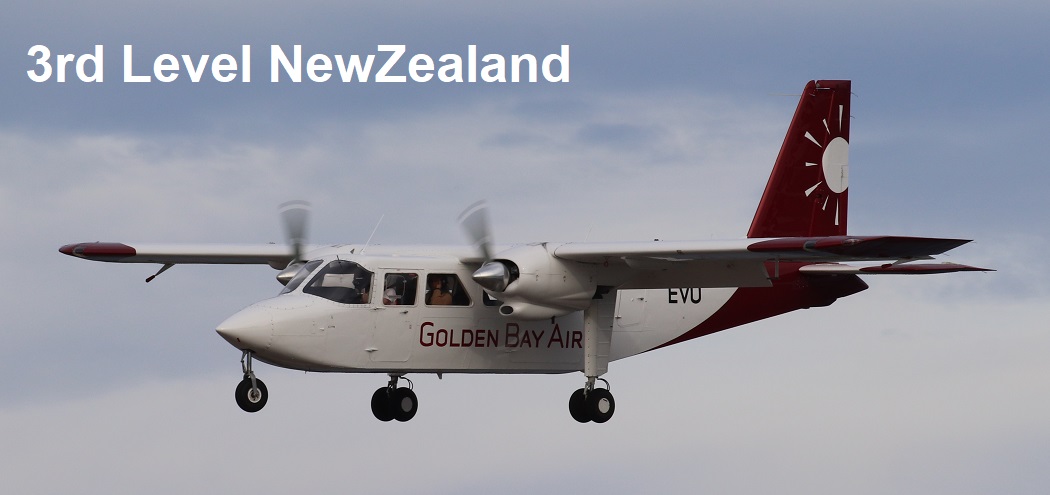Among the deaths notices of Saturday's NZ Herald was that of Ian Ritchie's founder of Ritchie Air Services and pioneer pilot in the Fiordland area. I found this piece on the Southern District's Aero Club site to celebrate when Ian was awarded the Jean Batton Trophy.
IAN ANDREW RITCHIE
Ian Andrew Ritchie was born in 1921 and is one of the doyens of the post-war development of general aviation, agricultural and the tourist air service industry in New Zealand.
At the outbreak of the Second World War, he applied to join the Royal New Zealand Air Force. After undertaking a correspondence course of pre-training and initial pilot qualification, he was posted to Canada for advanced flying training and eventually arrived at RAF Grantham in July 1943. A period on Blenheims was followed by operational tours on Beaufighters, where he earned an exceptional rating in air gunnery, and on Mosquitos, flying night and low-level raids over Germany. After the war ended he declined an invitation to join RAF Transport Command and, together with his wife Della Shaw, returned to New Zealand in 1946 to establish a furniture making business in Dunedin.
He obtained his A endorsed licence (today’s PPL) in August 1946 flying from Taieri. In 1948, he joined No. 4 Territorial Squadron Royal New Zealand Air Force flying Harvards and Tiger Moths, a reserve obligation to the RNZAF that he continued over many years. In March 1949 he earned his B licence (CPL) and shared his woodworking with part-time commercial flying during the week, Territorial Air Force on the weekends and studying for his instructor rating.
In 1950, in partnership with Ron Bush, his pre-war instructor, he established Southland and Otago Aerial Topdressing Ltd as Manager and Chief Pilot operating from Gore. The following year he undertook instructing for the Gore Flight of the Southland Aero Club in an honorary capacity on Sundays while the other six days a week were spent topdressing. SOAT was the pioneer South Island operator of the Fletcher FU24 and Ian Ritchie flew and demonstrated the aircraft extensively, including at the world’s first Agricultural Air Show in Palmerston North in November 1956. In December of that year he demonstrated the aircraft and its capabilities to the Duke of Edinburgh at Cashmere near Christchurch.
In 1959 he was awarded an A Category instructor licence. In 1960 he formed Ritchie Air Services, the first Southland air transport service, and obtained a licence to operate the first training school for agricultural (topdressing) pilots in New Zealand, flying Cessna 180 and DH82 aircraft. Soon after, the Gore branch of the SAC became the brand new Southern Districts Aero Club and Ian Ritchie was its first CFI.
Ritchie Air Services pioneered tourist air services from Te Anau, notably the spectacular route to Milford Sound, using Cessna 180 and a DH89 Dominie aircraft. It also engaged extensively in supply dropping and venison recovery in the mountainous terrain as well as floatplane operations from the lakes and sounds of the region. His humorous personality and engaging sense of confidence made him popular with his passengers and, while known as a strict disciplinarian, anecdotes of his exploits are legion among his contemporaries. In 1964, Ian and Della’s expanding airline merged with Tourist Air Travel which boosted its financial health and enabled the purchase of the first Cessna 206 floatplane in NZ and a further Dominie.
His years of instructing and display flying (one-time national aerobatic champion), together with his pioneering development of agricultural flying, tourist air services, and general aviation in Southland, had marked Ian as one of the most experienced General Aviation pilots in New Zealand. Accordingly, in 1966 he was invited to join the Civil Aviation Authority (CAA) as an Operations Officer in Wellington and this was the beginning of a 15-year era of a challenging and constructive contribution to aviation development in New Zealand. His new duties included prototype test flying of the CT4 Airtrainer and the turbine powered Fletcher FU24 as well as pilot flight testing, ratings and standards.
Committed to his instructional duties, he served voluntarily as the CFI at the annual Walsh Memorial Scout Flying School from the inaugural camp in 1967 until 1974, again leaving a legacy of strict standards and happy professionalism with several hundred young students. Ian Ritchie retired on the eve of his 60th birthday with over 13,000 hours logged. His role in the development of agricultural, tourism and general aviation services and standards in New Zealand and his instruction of aerial topdressing techniques, safe mountain flying techniques, instrument flying procedures and sound commercial operating standards in remote airspace have made an outstanding personal contribution to New Zealand aviation. He is accordingly awarded the Jean Batten Memorial Trophy.
Ian died at Motueka on the 18th of August 2010. May he rest in peace.
Ritchie Air Services' first De Havilland 89B Dominie, ZK-ALB at Christchurch
The second Dominie, ZK-AKY, over Fiordland reflecting its previous ownership by NAC (above) and after Ritchie Air Services' takeover by Tourist Air Travel at Dunedin on 8 October 1965 (below)











.jpg)


.jpg)
.jpg)

.jpg)
.jpg)



.jpg)
.jpg)










.jpg)
.jpg)




.jpg)
.jpg)
.jpg)









